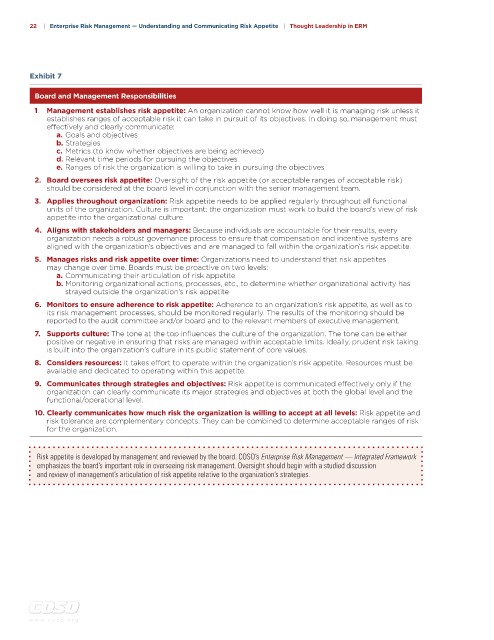Page 711 - COSO Guidance
P. 711
22 | Enterprise Risk Management — Understanding and Communicating Risk Appetite | Thought Leadership in ERM
Exhibit 7
Board and Management Responsibilities
1. Management establishes risk appetite: An organization cannot know how well it is managing risk unless it
establishes ranges of acceptable risk it can take in pursuit of its objectives. In doing so, management must
effectively and clearly communicate:
a. Goals and objectives
b. Strategies
c. Metrics (to know whether objectives are being achieved)
d. Relevant time periods for pursuing the objectives
e. Ranges of risk the organization is willing to take in pursuing the objectives
2. Board oversees risk appetite: Oversight of the risk appetite (or acceptable ranges of acceptable risk)
should be considered at the board level in conjunction with the senior management team.
3. Applies throughout organization: Risk appetite needs to be applied regularly throughout all functional
units of the organization. Culture is important: the organization must work to build the board’s view of risk
appetite into the organizational culture.
4. Aligns with stakeholders and managers: Because individuals are accountable for their results, every
organization needs a robust governance process to ensure that compensation and incentive systems are
aligned with the organization’s objectives and are managed to fall within the organization’s risk appetite.
5. Manages risks and risk appetite over time: Organizations need to understand that risk appetites
may change over time. Boards must be proactive on two levels:
a. Communicating their articulation of risk appetite
b. Monitoring organizational actions, processes, etc., to determine whether organizational activity has
strayed outside the organization’s risk appetite
6. Monitors to ensure adherence to risk appetite: Adherence to an organization’s risk appetite, as well as to
its risk management processes, should be monitored regularly. The results of the monitoring should be
reported to the audit committee and/or board and to the relevant members of executive management.
7. Supports culture: The tone at the top influences the culture of the organization. The tone can be either
positive or negative in ensuring that risks are managed within acceptable limits. Ideally, prudent risk taking
is built into the organization’s culture in its public statement of core values.
8. Considers resources: It takes effort to operate within the organization’s risk appetite. Resources must be
available and dedicated to operating within this appetite.
9. Communicates through strategies and objectives: Risk appetite is communicated effectively only if the
organization can clearly communicate its major strategies and objectives at both the global level and the
functional/operational level.
10. Clearly communicates how much risk the organization is willing to accept at all levels: Risk appetite and
risk tolerance are complementary concepts. They can be combined to determine acceptable ranges of risk
for the organization.
Risk appetite is developed by management and reviewed by the board. COSO’s Enterprise Risk Management — Integrated Framework
emphasizes the board’s important role in overseeing risk management. Oversight should begin with a studied discussion
and review of management’s articulation of risk appetite relative to the organization’s strategies.
w w w . c o s o . o r g

